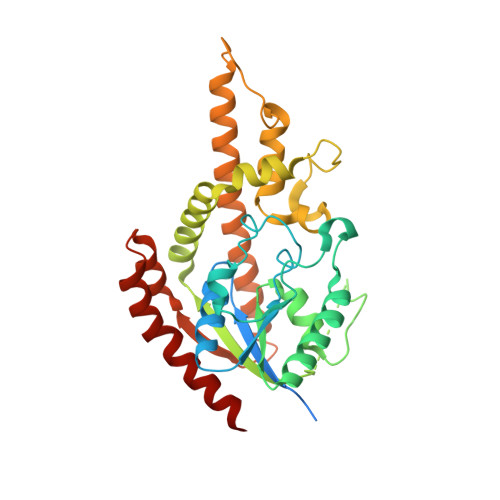Crystal structure and substrate specificity of plant adenylate isopentenyltransferase from Humulus lupulus: distinctive binding affinity for purine and pyrimidine nucleotides
Chu, H.-M., Ko, T.-P., Wang, A.H.-J.(2010) Nucleic Acids Res 38: 1738-1748
- PubMed: 20007608
- DOI: https://doi.org/10.1093/nar/gkp1093
- Primary Citation of Related Structures:
3A8T - PubMed Abstract:
Cytokinins are important plant hormones, and their biosynthesis most begins with the transfer of isopentenyl group from dimethylallyl diphosphate (DMAPP) to the N6-amino group of adenine by either adenylate isopentenyltransferase (AIPT) or tRNA-IPT. Plant AIPTs use ATP/ADP as an isopentenyl acceptor and bacterial AIPTs prefer AMP, whereas tRNA-IPTs act on specific sites of tRNA. Here, we present the crystal structure of an AIPT-ATP complex from Humulus lupulus (HlAIPT), which is similar to the previous structures of Agrobacterium AIPT and yeast tRNA-IPT. The enzyme is structurally homologous to the NTP-binding kinase family of proteins but forms a solvent-accessible channel that binds to the donor substrate DMAPP, which is directed toward the acceptor substrate ATP/ADP. When measured with isothermal titration calorimetry, some nucleotides displayed different binding affinities to HlAIPT with an order of ATP > dATP approximately ADP > GTP > CTP > UTP. Two basic residues Lys275 and Lys220 in HlAIPT interact with the beta and gamma-phosphate of ATP. By contrast, the interactions are absent in Agrobacterium AIPT because they are replaced by the acidic residues Asp221 and Asp171. Despite its structural similarity to the yeast tRNA-IPT, HlAIPT has evolved with a different binding strategy for adenylate.
Organizational Affiliation:
Institute of Biochemical Sciences, National Taiwan University, Taipei, 106, Taiwan.
















